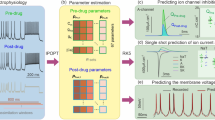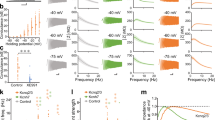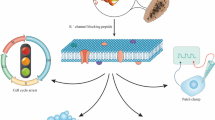Abstract
Aim:
To establish an improved, high-throughput screening techniques for identifying novel KCNQ2 channel activators.
Methods:
KCNQ2 channels were stably expressed in CHO cells (KCNQ2 cells). Thallium flux assay was used for primary screening, and 384-well automated patch-clamp IonWorks Barracuda was used for hit validation. Two validated activators were characterized using a conventional patch-clamp recording technique.
Results:
From a collection of 80 000 compounds, the primary screening revealed a total of 565 compounds that potentiated the fluorescence signals in thallium flux assay by more than 150%. When the 565 hits were examined in IonWorks Barracuda, 38 compounds significantly enhanced the outward currents recorded in KCNQ2 cells, and were confirmed as KCNQ2 activators. In the conventional patch-clamp recordings, two validated activators ZG1732 and ZG2083 enhanced KCNQ2 currents with EC50 values of 1.04±0.18 μmol/L and 1.37±0.06 μmol/L, respectively.
Conclusion:
The combination of thallium flux assay and IonWorks Barracuda assay is an efficient high-throughput screening (HTS) route for discovering KCNQ2 activators.
Similar content being viewed by others
Log in or create a free account to read this content
Gain free access to this article, as well as selected content from this journal and more on nature.com
or
References
Brown DA, Adams PR . Muscarinic suppression of a novel voltage-sensitive K+ current in a vertebrate neurone. Nature 1980; 283 673–6.
Robbins J . KCNQ potassium channels: physiology, pathophysiology, and pharmacology. Pharmacol Ther 2001; 90 1–19.
Xiong Q, Gao Z, Wang W, Li M . Activation of Kv7 (KCNQ) voltage-gated potassium channels by synthetic compounds. Trends Pharmacol Sci 2008; 29 99–107.
Brown DA, Passmore GM . Neural KCNQ (Kv7) channels. Br J Pharmacol 2009; 156 1185–95.
Piccinin S, Randall AD, Brown JT . KCNQ/Kv7 channel regulation of hippocampal gamma-frequency firing in the absence of synaptic transmission. J Neurophysiol 2006; 95 3105–12.
Yue C, Yaari Y . KCNQ/M channels control spike afterdepolarization and burst generation in hippocampal neurons. J Neurosci 2004; 24 4614–24.
Charlier C, Singh NA, Ryan SG, Lewis TB, Reus BE, Leach RJ, et al. A pore mutation in a novel KQT-like potassium channel gene in an idiopathic epilepsy family Nat Genet 1998; 18: 53–5.
Singh NA, Charlier C, Stauffer D, DuPont BR, Leach RJ, Melis R, et al. A novel potassium channel gene, KCNQ2, is mutated in an inherited epilepsy of newborns. Nat Genet 1998; 18: 25–9.
Tatulian L, Delmas P, Abogadie FC, Brown DA . Activation of expressed KCNQ potassium currents and native neuronal M-type potassium currents by the anti-convulsant drug retigabine. J Neurosci 2001; 21 5535–45.
Zheng Y, Xu H, Zhan L, Zhou X, Chen X, Gao Z . Activation of peripheral KCNQ channels relieves gout pain. Pain 2015; 156 1025–35.
Bentzen BH, Schmitt N, Calloe K, Brown W, Grunnet M, Olesen SP . The acrylamide (S)-1 differentially affects Kv7 (KCNQ) potassium channels. Neuropharmacology 2006; 51 1068–77.
Blom SM, Schmitt N, Jensen HS . The acrylamide (S)-2 as a positive and negative modulator of Kv7 channels expressed in Xenopus laevis oocytes. PLoS One 2009; 4 e8251.
Fritch PC, McNaughton-Smith G, Amato GS, Burns JF, Eargle CW, Roeloffs R, et al. Novel KCNQ2/Q3 agonists as potential therapeutics for epilepsy and neuropathic pain. J Med Chem 2011; 53: 887–96.
Jia C, Qi J, Zhang F, Mi Y, Zhang X, Chen X, et al. Activation of KCNQ2/3 potassium channels by novel pyrazolo[1,5-a]pyrimidin-7(4H)-one derivatives. Pharmacology 2011; 87: 297–310.
Peretz A, Pell L, Gofman Y, Haitin Y, Shamgar L, Patrich E, et al. Targeting the voltage sensor of Kv7.2 voltage-gated K+ channels with a new gating-modifier. Proc Natl Acad Sci U S A 2010; 107 15637–42.
Wickenden AD, Krajewski JL, London B, Wagoner PK, Wilson WA, Clark S, et al. N-(6-chloro-pyridin-3-yl)-3,4-difluoro-benzamide (ICA-27243): a novel, selective KCNQ2/Q3 potassium channel activator. Mol Pharmacol 2008; 73: 977–86.
Li P, Chen Z, Xu H, Sun H, Li H, Liu H, et al. The gating charge pathway of an epilepsy-associated potassium channel accommodates chemical ligands. Cell Res 2013; 23: 1106–18.
Wagoner PK, Oxford GS . Cation permeation through the voltage-dependent potassium channel in the squid axon. Characteristics and mechanisms. J Gen Physiol 1987; 90: 261–90.
Raphemot R, Kadakia RJ, Olsen ML, Banerjee S, Days E, Smith SS, et al. Development and validation of fluorescence-based and automated patch clamp-based functional assays for the inward rectifier potassium channel Kir4.1. Assay Drug Dev Technol 2013; 11: 532–43.
Yu H, Xu K, Zou B, Wu M, McManus OB, Le Engers J, et al. Identification of a novel, small molecule inhibitor of KCNQ2 channels. Probe Reports from the NIH Molecular Libraries Program [Internet]. Bethesda (MD): National Center for Biotechnology Information (US) 2010–2011 Oct 28.
Li Q, Rottlander M, Xu M, Christoffersen CT, Frederiksen K, Wang MW, et al. Identification of novel KCNQ4 openers by a high-throughput fluorescence-based thallium flux assay. Anal Biochem 2011; 418: 66–72.
Ion channel screening – automated patch clamp on the rise. Drug Discov Today Technol 2008; 5 e1–e34.
Lepple-Wienhues A, Lassen D, Hummer A, Czubayko U, Knirsch M, Golubovic A, et al. The Chiptip: a novel tool for automated patch clamp. Comb Chem High Throughput Screen 2009; 12: 73–7.
Shieh CC . Automated high-throughput patch-clamp techniques. Drug Discov Today 2004; 9 551–2.
Yu H, Wu M, Hopkins C, Engers J, Townsend S, Lindsley C, et al. A small molecule activator of KCNQ2 and KCNQ4 channels. Probe Reports from the NIH Molecular Libraries Program [Internet]. Bethesda (MD): National Center for Biotechnology Information (US) 2010–2011 Mar 29.
Mattmann ME, Yu H, Lin Z, Xu K, Huang X, Long S, et al. Identification of (R)-N-(4-(4-methoxyphenyl)thiazol-2-yl)-1-tosylpiperidine-2-carboxamide, ML277, as a novel, potent and selective K(v)7.1 (KCNQ1) potassium channel activator. Bioorg Med Chem Lett 2012; 22 5936–41.
Py C, Martina M, Diaz-Quijada GA, Luk CC, Martinez D, Denhoff MW, et al. From understanding cellular function to novel drug discovery: the role of planar patch-clamp array chip technology. Front Pharmacol 2011; 2: 51.
Carmelle V . Conventional Patch Clamp Techniques and High-Throughput Patch Clamp Recordings on a Chip for Measuring Ion Channel Activity, in Textbook of Pulmonary Vascular Disease 2010; Springer. USA. P 495–510.
Schroeder K, Neagle B, Trezise DJ, Worley J . Ionworks HT: a new high-throughput electrophysiology measurement platform. J Biomol Screen 2003; 8 50–64.
Acknowledgements
We gratefully acknowledge the financial support from the National Natural Science Foundation of China Grant for Excellent Key Laboratory (81123004), the National Natural Science Foundation of China (61327014, 61175103 and 91413122), Shanghai Municipal Science and Technology Commission (13JC1406700) and the External Cooperation Program of BIC, Chinese Academy of Sciences (1536631KYSB20130003).
Author information
Authors and Affiliations
Corresponding authors
Additional information
Supplementary Table S1 is available at Acta Pharmacologica Sinica's website.
Supplementary information
Supplementary Information, Table S1
Potentiation activity of validated hits on KCNQ2 currents. (DOCX 252 kb)
Rights and permissions
About this article
Cite this article
Yue, Jf., Qiao, Gh., Liu, N. et al. Novel KCNQ2 channel activators discovered using fluorescence-based and automated patch-clamp-based high-throughput screening techniques. Acta Pharmacol Sin 37, 105–110 (2016). https://doi.org/10.1038/aps.2015.142
Received:
Accepted:
Published:
Issue date:
DOI: https://doi.org/10.1038/aps.2015.142
Keywords
This article is cited by
-
Novel KCNQ2 missense variant expands the genotype spectrum of DEE7
Neurological Sciences (2024)
-
Ion channels research in the post-genomic era
Acta Pharmacologica Sinica (2016)



